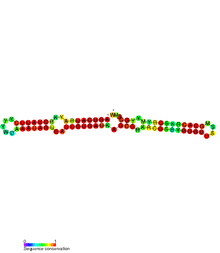SymE-SymR toxin-antitoxin system
| SymR | |
|---|---|
 Conserved secondary structure of SymR RNA. | |
| Identifiers | |
| Symbol | SymR |
| Rfam | RF01809 |
| Other data | |
| RNA type | Antisense RNA |
| Domain(s) | E. coli |
| SO | {{{SO}}} |
| PDB structures | PDBe |
| SymE Toxin of Type I toxin-antitoxin system | |||||||||
|---|---|---|---|---|---|---|---|---|---|
| Identifiers | |||||||||
| Symbol | SymE_toxin | ||||||||
| Pfam | PF13957 | ||||||||
| |||||||||
The SymE-SymR toxin-antitoxin system consists of a small hydrophobic toxin named SymE and a non-coding RNA called SymR which inhibits its translation.[1] It is a type I toxin-antitoxin system, and is under regulation by the antitoxin, SymR.[2]
Discovery of the system
SymR was originally labelled RyjC and is a 77nt RNA with a σ70 promoter. RyjC was found to overlap the yjiW open reading frame on the opposite strand by 6nt, and was characterised as an antisense RNA which bound the 5' untranslated region of yjiW.[3] Further study led to the renaming of both yjiW and RyjC to SymE (SOS-induced yjiW gene with similarity to MazE) and SymR (symbiotic RNA) respectively.[1]
Mechanism of toxicity
SymR blocks translation of SymE by antisense binding. SymE exhibits its toxicity by repressing global translation within the cell, cleaving mRNA in a similar manner to MazF, another toxin.[4] Quantitative Northern blot experiments showed that SymR RNA is present in cells at 10 times the concentration of SymE mRNA (0.02 fmol μg−1 and 0.2 fmol μg−1).[1]
Following DNA damage, the SOS response represses transcription of SymR RNA, allowing SymE toxin to degrade potentially damaged mRNA until the DNA has been repaired.[1]
See also
References
- 1 2 3 4 Kawano M, Aravind L, Storz G (May 2007). "An antisense RNA controls synthesis of an SOS-induced toxin evolved from an antitoxin". Mol. Microbiol. 64 (3): 738–54. doi:10.1111/j.1365-2958.2007.05688.x. PMC 1891008. PMID 17462020.
- ↑ Kawano, M (December 2012). "Divergently overlapping cis-encoded antisense RNA regulating toxin-antitoxin systems from E. coli: hok/sok, ldr/rdl, symE/symR". RNA Biology. 9: 1520–7. doi:10.4161/rna.22757. PMID 23131729.
- ↑ Kawano M, Reynolds AA, Miranda-Rios J, Storz G (2005). "Detection of 5'- and 3'-UTR-derived small RNAs and cis-encoded antisense RNAs in Escherichia coli". Nucleic Acids Res. 33 (3): 1040–50. doi:10.1093/nar/gki256. PMC 549416. PMID 15718303. Retrieved 2010-08-26.
- ↑ Gerdes K, Wagner EG (April 2007). "RNA antitoxins". Curr. Opin. Microbiol. 10 (2): 117–24. doi:10.1016/j.mib.2007.03.003. PMID 17376733. Retrieved 2010-08-26.
Further reading
- Buts L, Lah J, Dao-Thi MH, Wyns L, Loris R (December 2005). "Toxin-antitoxin modules as bacterial metabolic stress managers". Trends Biochem. Sci. 30 (12): 672–9. doi:10.1016/j.tibs.2005.10.004. PMID 16257530. Retrieved 2010-08-26.
- Gerdes K, Christensen SK, Løbner-Olesen A (May 2005). "Prokaryotic toxin-antitoxin stress response loci". Nat. Rev. Microbiol. 3 (5): 371–82. doi:10.1038/nrmicro1147. PMID 15864262.
- Lewis LK, Harlow GR, Gregg-Jolly LA, Mount DW (August 1994). "Identification of high affinity binding sites for LexA which define new DNA damage-inducible genes in Escherichia coli". J. Mol. Biol. 241 (4): 507–23. doi:10.1006/jmbi.1994.1528. PMID 8057377. Retrieved 2010-08-26.
- Christensen SK, Pedersen K, Hansen FG, Gerdes K (September 2003). "Toxin-antitoxin loci as stress-response-elements: ChpAK/MazF and ChpBK cleave translated RNAs and are counteracted by tmRNA". J. Mol. Biol. 332 (4): 809–19. doi:10.1016/S0022-2836(03)00922-7. PMID 12972253. Retrieved 2010-08-26.
- Engelberg-Kulka H, Glaser G (1999). "Addiction modules and programmed cell death and antideath in bacterial cultures". Annu. Rev. Microbiol. 53: 43–70. doi:10.1146/annurev.micro.53.1.43. PMID 10547685. Retrieved 2010-08-26.
- Cherepanov PP, Wackernagel W (May 1995). "Gene disruption in Escherichia coli: TcR and KmR cassettes with the option of Flp-catalyzed excision of the antibiotic-resistance determinant". Gene. 158 (1): 9–14. doi:10.1016/0378-1119(95)00193-A. PMID 7789817. Retrieved 2010-08-26.
- Anantharaman V, Aravind L (2003). "New connections in the prokaryotic toxin-antitoxin network: relationship with the eukaryotic nonsense-mediated RNA decay system". Genome Biol. 4 (12): R81. doi:10.1186/gb-2003-4-12-r81. PMC 329420. PMID 14659018. Retrieved 2010-08-26.